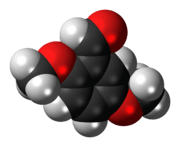2,5-Dimethoxybenzaldehyde
2,5-Dimethoxybenzaldehyde is an organic compound and a benzaldehyde derivative. One of its uses is the production of 2,5-dimethoxyphenethylamine, also known as 2C-H. 2C-H is used to produce many other substituted phenethylamines such as 2C-B, 2C-I and 2C-C.[1]
 | |
 | |
| Names | |
|---|---|
| IUPAC name
2,5-Dimethoxybenzaldehyde | |
| Identifiers | |
3D model (JSmol) |
|
| ChemSpider | |
| ECHA InfoCard | 100.002.011 |
| EC Number |
|
PubChem CID |
|
| UNII | |
CompTox Dashboard (EPA) |
|
| |
| |
| Properties | |
| C9H10O3 | |
| Molar mass | 166.17 g/mol |
| Appearance | Yellow crystalline solid |
| Density | 1.114 g/mL |
| Melting point | 50 °C (122 °F; 323 K) |
| Boiling point | 283.8 °C (542.8 °F; 557.0 K) |
| Hazards | |
| Main hazards | Irritant |
| R-phrases (outdated) | R38 R41 |
| S-phrases (outdated) | S26 S36/37 |
| NFPA 704 (fire diamond) | |
| Flash point | 110 °C (230 °F; 383 K) (c.c.) |
Except where otherwise noted, data are given for materials in their standard state (at 25 °C [77 °F], 100 kPa). | |
| Infobox references | |
References
- Shulgin, Alexander; Shulgin, Ann (September 1991). PiHKAL: A Chemical Love Story. Berkeley, California: Transform Press. ISBN 0-9630096-0-5. OCLC 25627628.
This article is issued from Wikipedia. The text is licensed under Creative Commons - Attribution - Sharealike. Additional terms may apply for the media files.
